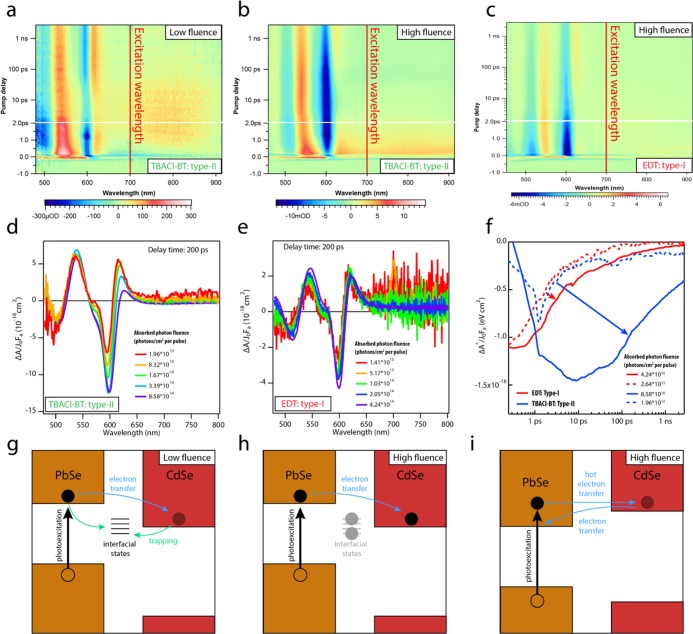Figure 3.
Transient absorption (TA) measurements of electron dynamics in CdSe–PbSe QD heterojunction films upon selective PbSe excitation. (a) TA color map of the TBACl/BT film, excited at 700 nm with an absorbed fluence of 1.96 × 101 3 photons/cm2 per pulse. The CdSe band-edge signal is characterized by a bleach feature that decays rapidly and is replaced by a derivative-like feature. (b) TA color map of the TBACl/BT film, excited at 700 nm with an absorbed fluence of 8.58 × 1014 photons/cm2 per pulse. A long-lived bleach is present at the CdSe band edge. (c) TA color map of the EDT film, excited at 700 nm with an absorbed fluence of 4.24 × 1014 photons/cm2 per pulse. The CdSe bleach is short-lived. (d) Absorbed fluence-normalized TA signal of the TBACl/BT film excited at 700 nm with different photon fluences, obtained at a delay time of 200 ps. With increasing photon fluence, the signal evolves from a derivative-like feature to a Gaussian bleach. (e) Absorbed fluence-normalized TA signal of the EDT film excited at 700 nm with different photon fluences, obtained at a delay time of 200 ps. The shape of the signal at the CdSe band gap is weakly influenced by the absorbed fluence. (f) Time dependence of the energy-integrated band gap signal (see the Supporting Information) of the EDT sample (red) and TBACl-BT sample (blue), for low (dotted-line) and high (continuous line) fluence. As the fluence increases, the bleach lifetime in the TBACl-BT film increases dramatically, while in the EDT sample, it is hardly affected. (g–i) Schemes representing electron transfer processes occurring in the (g, h) type-II film and in the (i) type-I film. For the type-II film, at low fluence, electrons are rapidly trapped at interfacial states (g), and higher fluence is needed to saturate the trap states and allow long-lived electron occupation of the CdSe CB edge (h). In the (i) type-I film, the electron dynamics is described by hot-electron transfer to the CdSe QDs, followed by back-transfer to the PbSe QDs.35

